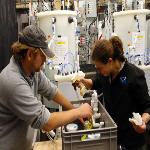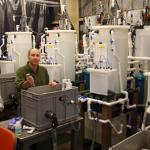12 October 2010

Photo: VOA - T. Banse
NOAA researchers Mike Maher and Shallin Busch check the pH of a seawater tank.
Baby oysters could be the "canaries in the mine shaft" for another dimension of global warming.
Pacific Northwest scientists are studying how the oceans suck in excess carbon dioxide from the atmosphere. The process changes seawater chemistry - locally and globally. An experiment now under way in Seattle, Washington to find out how sea critters are coping with the changes.
Time machine
Paul McElhany's lab is like an ocean time machine.
"In one of the tanks we're simulating pre-industrial conditions, before people started burning fossil fuels," says McElhany, a federal biologist working at the Northwest Fisheries Science Center in Seattle.
Multicolored tubes and pipes run every which way in the cramped aquatic lab. The researcher controls his time machine by bubbling carbon dioxide into the seawater at different concentrations.
"The next tank over, we're setting conditions of doubling of the current CO2 levels, which the models that have been done project we'll reach by 2100, by the end of the century or before," says McElhany.

VOA - T. Banse
NOAA Fisheries biologist Paul McElhany in his Seattle lab.Ocean acidification
There's one additional setup with an even worse scenario. McElhany explains the oceans absorb a big chunk of the CO2 we pump into the atmosphere. This is the lesser known twin of atmospheric warming. Scientists call it "ocean acidification."
"As the CO2 that's put out by burning fossil fuels goes into the ocean, it changes the chemistry of the ocean itself and makes it more acidic," he says. "It's sort of the same way as when you have carbon dioxide in a soda pop, that makes the soda pop more acidic."
Ocean acidification is not going to affect all species equally. McElhany's team is trying to determine just who wins and who loses. On the one hand, algae and seaweed could prosper under elevated carbon dioxide levels. On the other, shellfish in the larval stage seem quite vulnerable.
"If the acidity gets low enough," says McElhany, "they can actually start to dissolve."
First into the bath, baby oysters. The little creatures are taking an extended dip now with the ghosts of oceans past, present and future. Next up, abalone, geoducks, clams, mussels and krill. Grad students check the tanks and jars every day to monitor how many larvae survive and in what condition.
Oyster test
At Oregon State University, researchers are waiting to hear if the National Science Foundation will provide money for a similar experiment. Fisheries professor Chris Langdon says oysters are likely to show the effects of a more acidic ocean first.
"From what we can tell, the larvae of the Pacific oyster seem to be much more sensitive to what's going on than larvae of mussels or clams. So they are kind of the canary in the mine shaft."
Pacific Northwest oyster growers already report having serious problems with oyster seed survival. They blame it on acidified water. Langdon says a frustrating discovery is that it's hard to get high levels of dissolved carbon dioxide out of seawater once it's in there.
So where does that leave people like western Washington oysterman and clam grower Bill Dewey?
"The likelihood of turning it around anytime soon is not good," says Dewey. "So we're definitely, in our industry, we're in the adaption mode, trying to find things we can do to the seawater chemistry in our hatcheries to allow us to produce the seed."
Researchers hope to explore possible water treatments for aquaculture farms and Dewey says he's heartened by the scientific attention directed at his industry's problem.
Future of the world's oceans
Separately, Norwegian, German and British scientists are looking at how marine species from their waters respond to rising acidity.
American researchers met recently with counterparts from the United Kingdom to coordinate experiments and discuss how best to model the future of the world's oceans.
Another area with high vulnerability are coral reefs.
They are already showing the effects of a warmer and more acidic ocean. For purposes of science, the rub is that corals are harder to keep alive in a lab. But there's an important reason to keep trying. Coral reefs are hugely important breeding grounds for many fish. And although reefs cover less than one percent of the sea floor, they support about 25 percent of all life in the ocean.